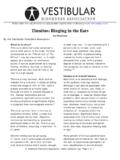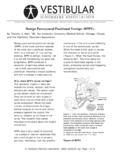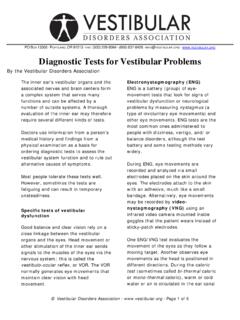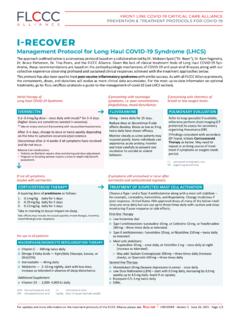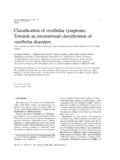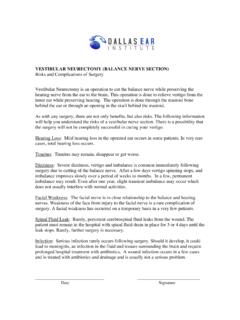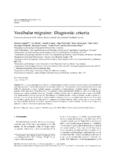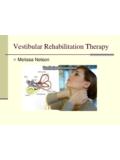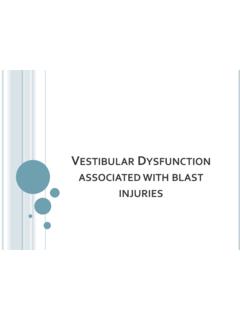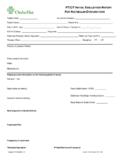Transcription of —An Effective, Evidence-Based Treatment
1 PO BOX 13305 PORTLAND, OR 97213 FAX: (503) 229-8064 (800) 837-8428 vestibular Rehabilitation An effective , Evidence-Based Treatment By Anne Shumway-Cook, PT, PhD; Professor Emerita, Department of Rehabilitation Medicine, University of Washington, Seattle, Washington People with vestibular inner ear disorders often experience problems with balance and position or movement-related dizziness. These primary symptoms are often accompanied by secondary symptoms associated with reduced activity levels.
2 Secondary symptoms include decreased strength, loss of range of motion, and increased tension (particularly in the cervical and shoulder region), leading to muscle fatigue and headaches. These symptoms affect a person s ability to change positions (such as lying down) or move about without imbalance and vertigo. Even moderate dizziness may be debilitating enough to diminish quality of life, reduce employability, and complicate all aspects of life. The result can be economic and social devastation.
3 vestibular rehabilitation is a specialized form of therapy designed to alleviate both primary and secondary symptoms of vestibular disorders. Frequency of inner ear disorders Dizziness and disequilibrium are common complaints reported by adults during visits to their doctors. Dizziness itself is not a disease it is a symptom that can result from a vestibular disorder or from difficulties unrelated to the inner ear, such as cardiovascular, neurological, metabolic, vision, or psychological disorders.
4 However, as many as 45% of people with dizziness symptoms have problems in the vestibular system (balance organs of the inner ear).1 What is vestibular rehabilitation? vestibular rehabilitation therapy (VRT) is an exercise- based program for reducing the symptoms of disequilibrium and dizziness associated with vestibular pathology (disease or disorder). A common neuro-otological approach for managing such symptoms is to prescribe medication that suppresses vestibular function. However, in the long term, such suppressants can interfere with a person s ability to make necessary adaptations.
5 In addition, many of these medications cause drowsiness that may limit a person s ability to be active. VRT is an alternative Treatment involving specific exercises that can eliminate or significantly reduce symptoms by promoting central nervous system compensation for inner-ear deficits. The program is designed to achieve these goals: 1. Decrease dizziness and visual symptoms. vestibular Disorders Association Page 2 of 8 2. Increase balance and walking functions. 3. Increase general activity levels.
6 The program may include exercises for: Coordinating eye and head movements Stimulating the symptoms of dizziness in order to desensitize the vestibular system Improving balance and walking ability Improving fitness and endurance Exercises vary depending on the type of inner-ear disorder and the associated symptoms. Who needs vestibular rehabilitation? It is critical that persons entering a VRT program have a confirmed diagnosis of vestibular pathology because not all dizziness is caused by vestibular deficits.
7 Most referrals come from otolaryngologists or neurologists. If there is some question about the nature of the underlying disorder in individuals who are referred from other sources, the treating therapist may request an otology consult. VRT can help with a variety of vestibular problems, including: benign paroxysmal positional vertigo (BPPV) and unilateral or bilateral vestibular hypofunction (reduced inner-ear function on one or both sides) associated with diagnoses such as M ni re s disease, labyrinthitis, and vestibular neuritis.
8 Even individuals with long-term unresolved inner ear disorders who have undergone a period of medical management with little or no success may benefit. VRT can also help people with an acute or abrupt loss of vestibular function following surgery for vestibular problems. Does therapy succeed? The best available clinical evidence2,3 shows VRT exercises to be effective in reducing symptoms of many types of vestibular disorders including symptoms that follow certain corrective surgical procedures for vestibular Treatment of BPPV using canalith-repositioning maneuvers (a series of head maneuvers that move displaced calcium carbonate crystals out of one of the semicircular canals of the inner ear)
9 Is, however, more effective than medication or other forms of exercise- based ,4 How will the therapist assess the problems? VRT begins with an assessment by a specially trained physical therapist or occu-pational therapist, who collects a medical history and uses different measures to identify the type and severity of symptoms. History: The therapist takes a compre-hensive medical history to document the type and intensity of symptoms and their effect on activities of daily living, previous treatments for the problem including the use of medications, whether the person has fallen or almost fallen, and current activity levels including the amount of exercise and whether the symptoms have caused a reduction in activity levels.
10 vestibular Disorders Association Page 3 of 8 I ve been told I need vestibular therapy to correct compensation strategies I use to help balance. What is a compensation strategy? The human balance system is complex. It depends upon coordinating motor (movement) responses to sensory information from three sources: vision, muscles and joints, and inner ears. A problem with any one of these sources can cause you to develop new patterns of movement to accommodate or compensate for the change.

